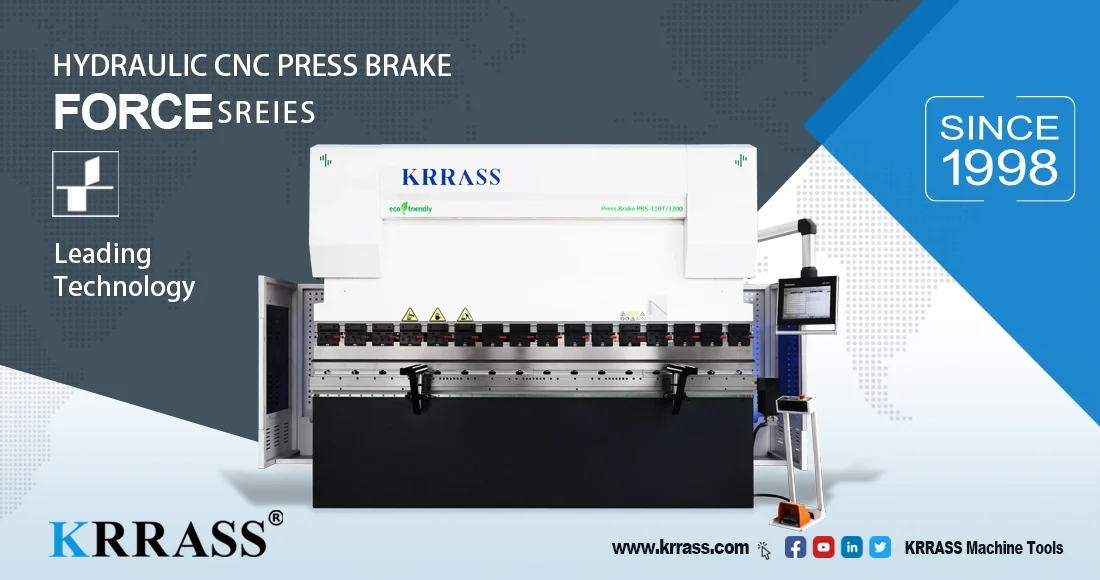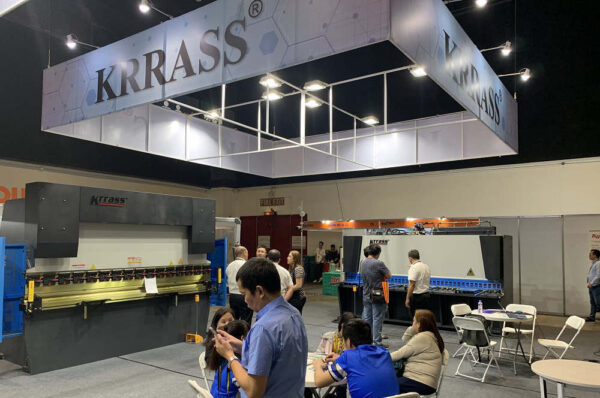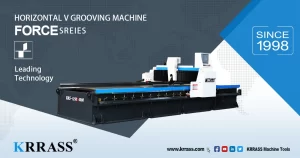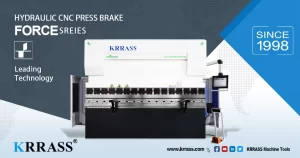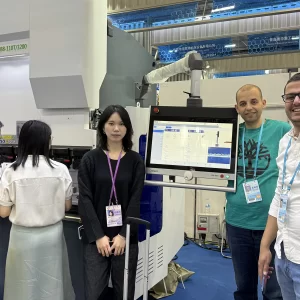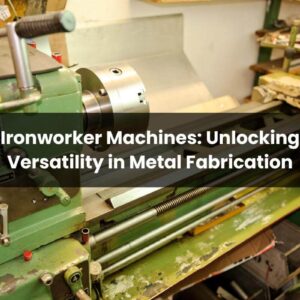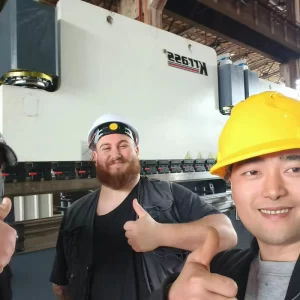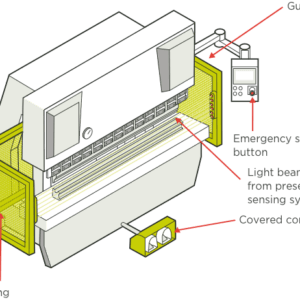CNC Press brakes
Sheet metal bending is the manufacturing process by which most enclosures, electrical boxes, brackets, and components are formed through the use of a machine known as a CNC press brake or (brake press). This technical article explains how fabrication companies bend sheet metal using these types of machines. We hope that after reading this technical article you will have a better understanding of how sheet metal bending works.
(Panel Bending machines can also be used, although their operation is outside the scope of this page.)
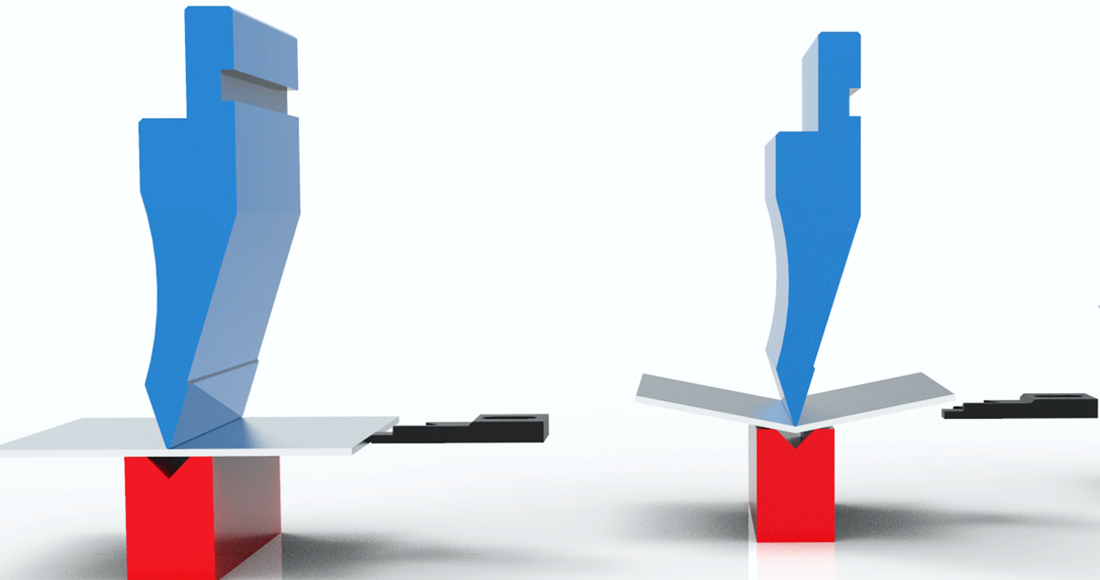
Bending Sheet Metal
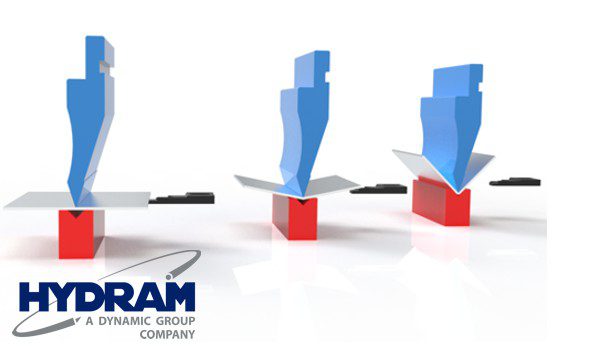 Sheet metal is bent when it is forced between two tools by the press brake: an upper tool (known as a punch) and a bottom tool (known as a V-die). The press brake controls the movement of either the punch or the die and provides the press force using hydraulic rams or electrical servo motors. The bend angle is predominantly determined by the depth of penetration of the punch within the V-die.
Sheet metal is bent when it is forced between two tools by the press brake: an upper tool (known as a punch) and a bottom tool (known as a V-die). The press brake controls the movement of either the punch or the die and provides the press force using hydraulic rams or electrical servo motors. The bend angle is predominantly determined by the depth of penetration of the punch within the V-die.
Air bending (three-point bending): Only the top two corners of the V-die touch the material and the inner radius of the bend is determined by how wide the V-die opening is, and not the radius of the punch tip.
Coining or bottom bending: The material comes into contact with the entire interior surface of the V-die and the punch tip forms the inner radius of the bend. Requires much greater force compared to air bending.
Air Bending Bend Radius
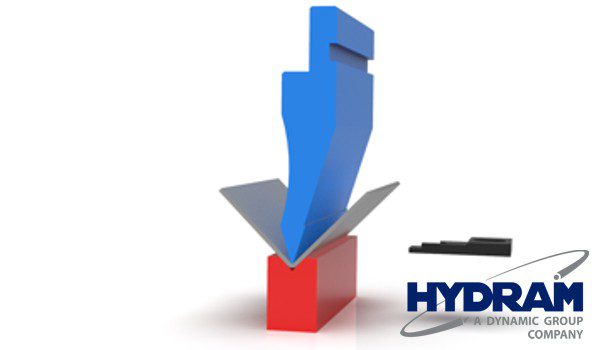 With air bending, the inside radius is predominantly determined by the V-die opening or V-width. It is preferable for any given material to use the largest practical die opening to minimise the force required, which results in a larger radius. Often a smaller radius is desirable and a good rule-of-thumb is to use a minimum inside radius equal to the material thickness. Dies are manufactured in particular sizes and this limits the choice of radii for a particular material. For this reason generous tolerances on the inside bend radii should be allowed for in the design (typically at least +/- 30% of the required dimension).
With air bending, the inside radius is predominantly determined by the V-die opening or V-width. It is preferable for any given material to use the largest practical die opening to minimise the force required, which results in a larger radius. Often a smaller radius is desirable and a good rule-of-thumb is to use a minimum inside radius equal to the material thickness. Dies are manufactured in particular sizes and this limits the choice of radii for a particular material. For this reason generous tolerances on the inside bend radii should be allowed for in the design (typically at least +/- 30% of the required dimension).
Bend Length / Flange Length
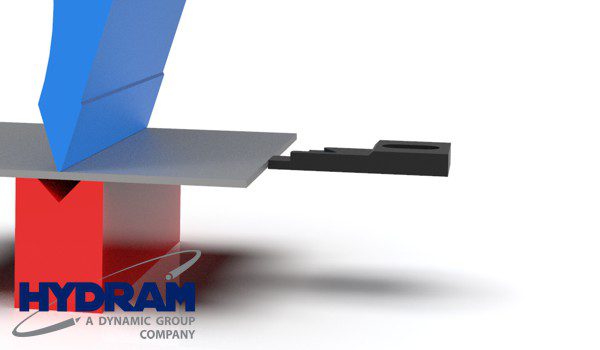 The bend length or flange lengths are determined by the position of the back stop or finger stop, shown in black in our images, against which the components are positioned before each bending operation. On our press brakes the stops are moterised and their position is controlled by the CNC program, allowing multiple different bend lengths to be achieved within the same program cycle.
The bend length or flange lengths are determined by the position of the back stop or finger stop, shown in black in our images, against which the components are positioned before each bending operation. On our press brakes the stops are moterised and their position is controlled by the CNC program, allowing multiple different bend lengths to be achieved within the same program cycle.
Depending on the width of the press brake, multiple different tooling stations can be set up so that a component requiring different tooling setups can be fully bent during one program run. Each of our press brakes have two back stops, but they have differing back stop movement capabilities, with our most capable machines able to have independent movement in all 3 axes, allowing maximum flexibility.
Sheet metal bending Part Design And Complexity
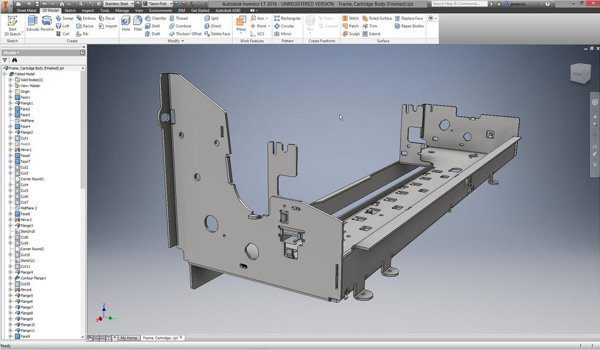 Components vary in complexity, from parts with a single bend, through to parts with multiple bends with multiple flange lengths. Modern press brakes are equipped with adjustable backstops, driven by servo motors, against which the components are offered by hand or robotic manipulator. The closer the backstop to the tooling, the shorter the resulting flange is and vice versa.
Components vary in complexity, from parts with a single bend, through to parts with multiple bends with multiple flange lengths. Modern press brakes are equipped with adjustable backstops, driven by servo motors, against which the components are offered by hand or robotic manipulator. The closer the backstop to the tooling, the shorter the resulting flange is and vice versa.
On complex parts, the backstops adjust after each bend to the corresponding distance required for the next bend. The movement of the backstops and the pressbrake tooling is synchronised by a CNC controller. CNC programs can be generated online on the machine user interface or by an offline programming (or CADCAM) software package.
CNC Press Brake Capabilities
The maximum force provided by the press brake determines the maximum bend length for a combination of thickness of sheet metal, bend radius and bend angle. The force required to bend sheet metal increases with bend length, external bend angle and sheet metal thickness, and it decreases with increasing bend radius. Hydram’s press brakes have varying capabilities and maximum bend length of 4 metres and a maximum force of 250 tonnes are available. The table below illustrates some typical examples for 90 degree bends using air bending (not coining).
| Mild Steel Thickness | Bend Length | Inner Bend Radius | Required Force |
|---|---|---|---|
CNC Press Brake Tooling
A variety of press brake tools is available to suit different sheet metal bending tasks. The characteristics of the upper and lower tools are varied according to the requirements of the sheet metal component.
Tools For Sheet Metal Bending Thick Metals
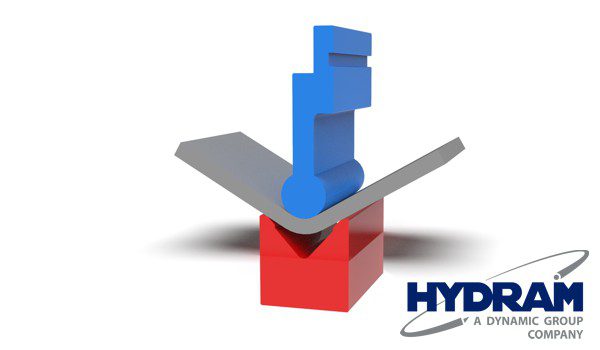 Thicker metal is generally processed with a larger bending radius, and this can be achieved by increasing the top tool radius and the distance across the V-die opening or V-width.
Thicker metal is generally processed with a larger bending radius, and this can be achieved by increasing the top tool radius and the distance across the V-die opening or V-width.
Tools For Sheet Metal Over Bending Acute Angles
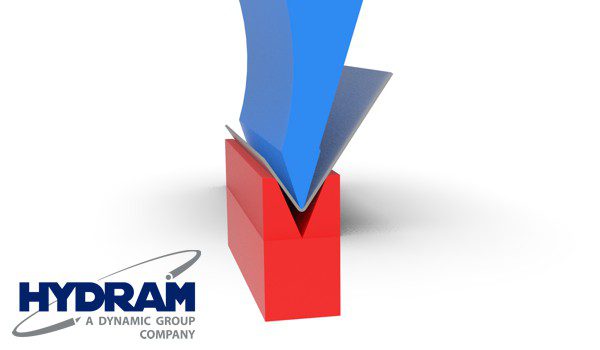 Components that require a sharp bend angle require “over bending” tooling. Both the top and bottom tools in this case have a more acute angle.
Components that require a sharp bend angle require “over bending” tooling. Both the top and bottom tools in this case have a more acute angle.
Tools For Sheet Metal Bending Tight Clearance
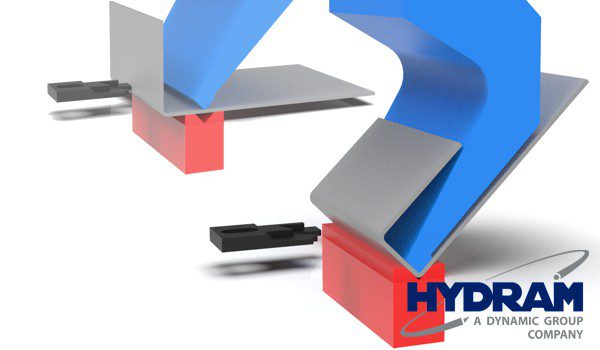 Components that have more than one bend often require special top tooling to provide clearance for existing flanges. Without this clearance the component would collide with the tool before the subsequent bend operation was complete. This type of tooling is often referred to as gooseneck.
Components that have more than one bend often require special top tooling to provide clearance for existing flanges. Without this clearance the component would collide with the tool before the subsequent bend operation was complete. This type of tooling is often referred to as gooseneck.
Modified Clamps
 To provide clearance in extreme cases, the top tool can be suspended from the press brake beam using modified clamps. These extended clamps provide far greater clearance for large flanges, so long as the press brake has sufficient stroke length to accommodate the overall tool height.
To provide clearance in extreme cases, the top tool can be suspended from the press brake beam using modified clamps. These extended clamps provide far greater clearance for large flanges, so long as the press brake has sufficient stroke length to accommodate the overall tool height.
Folded Sheet Metal Blank Development
Blank Size – Bending Allowance
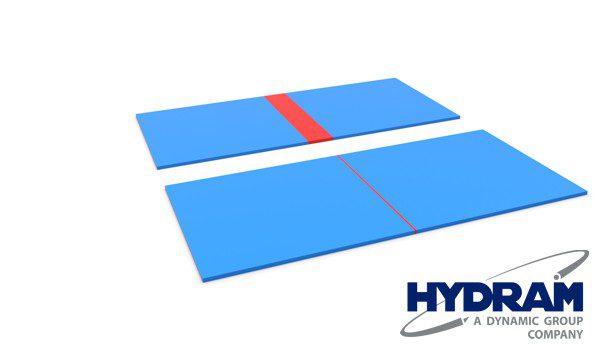 When designing sheet metal components with folds or bends it is necessary to create a flat pattern or blank development of the part. This blank is then laser cut or CNC punched before arriving at the press brake for folding. In creating the blank, it is important that the design takes into account the bend radius formed by the press brake tooling. The bend radius has the effect of decreasing the developed blank size. The larger the radius, the smaller the blank, as shown in the example oppsite. The design calculations required for sheet metal blank development are referred to as a “bending allowance” calculation.
When designing sheet metal components with folds or bends it is necessary to create a flat pattern or blank development of the part. This blank is then laser cut or CNC punched before arriving at the press brake for folding. In creating the blank, it is important that the design takes into account the bend radius formed by the press brake tooling. The bend radius has the effect of decreasing the developed blank size. The larger the radius, the smaller the blank, as shown in the example oppsite. The design calculations required for sheet metal blank development are referred to as a “bending allowance” calculation.
Bend Radius Consideration
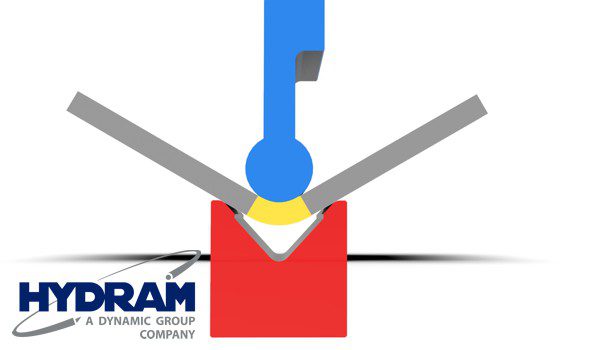 The bend radius varies with the material thickness and the tooling used for bending the material, and each subcontractor will have their own tooling preference, meaning that different subcontractors may use different blank developments. It is therefore essential that the production designer or engineer is aware what tooling will be used to bend the material and have a good appreciation what affect this has on the bend radius, and the resulting blank development size. Likewise, to ensure accuracy of the bent component, the press brake operator needs to know what radius the part has been designed with so that the correct tooling choice is made.
The bend radius varies with the material thickness and the tooling used for bending the material, and each subcontractor will have their own tooling preference, meaning that different subcontractors may use different blank developments. It is therefore essential that the production designer or engineer is aware what tooling will be used to bend the material and have a good appreciation what affect this has on the bend radius, and the resulting blank development size. Likewise, to ensure accuracy of the bent component, the press brake operator needs to know what radius the part has been designed with so that the correct tooling choice is made.
Learn more about our products, please visit and subscribe to our Youtube channel

